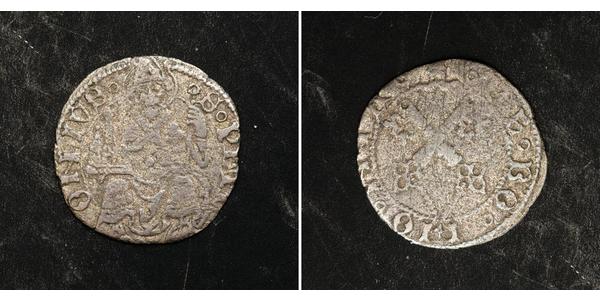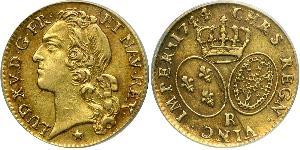(Vendue pour $22.0)
1464, Italian States, Bologna, Giovanni II Bentivoglio. Silver Quattrino (1/4 Grosso) Coin.
Mint Place: Bologna Reference: CNI 60 var. Mint Period: 1464-1480 AD Denomination: Quattrino (1/4 Grosso) Condition: Lightly corroded, otherwise F+ Diameter: 16mm Weight: 0.53gm Material: Silver
Obverse: Saint Petronius, wearing episcopal regalia, seated facing, holding model of city and crozier. Legend: ° S ° PETRVS - ONIVS °
Reverse: Crossed keys within inner circle. Legend: (papal tiara) ° DE ° BO ° NO ° NIA °
Bologna is the largest city (and the capital) of the Emilia-Romagna Region in Italy.
In the 11th century, under the Holy Roman Empire, Bologna began to aspire to being a free commune, which it was able to do when Matilda of Tuscany died, in 1115, and the following year the city obtained many judicial and economic concessions from Emperor Henry V. Bologna joined the Lombard League against Frederick Barbarossa in 1164 which ended with the Peace of Constance in 1183; after which, the city began to expand rapidly (this is the period in which its famous towers were built) and it became one of the main commercial trade centres thanks to a system of canals that allowed large ships to come and go.
Traditionally said to be founded in 1088, the University of Bologna is widely considered to be the first university. The university originated as an international centre of study of medieval Roman law under major glossators, including Irnerius. It numbered Dante, Boccaccio and Petrarca among its students.
In the 12th century, the expanding city needed a new line of walls, and at the end of the 13th century, Bologna had between 50,000 and 60,000 inhabitants making it the fifth largest city in Europe (after Cordova, Paris, Venice, and Florence) and tied with Milan as the largest textile industry area in Italy. The complex system of canals in Bologna was one of the most advanced waterway systems in Europe, and took its water from the Savena, Aposa and Reno Rivers. The main canals were Canale Navile, Canale di Reno and Canale di Savena. Hydraulic energy derived from the canal system helped run the numerous textile mills and transport goods.
In 1256, Bologna promulgated the "Paradise Law", which abolished feudal serfdom and freed the slaves, using public money. At that time the city centre was full of towers (perhaps 180), built by the leading families, notable public edifices, churches, and abbeys. In the 1270s Bologna's politics was dominated by Luchetto Gattilusio, a Genoese diplomat and man of letters who became the city Governor. Like most Italian cities of that age, Bologna was torn by internal struggles related to the Guelph and Ghibelline factions, which led to the expulsion of the Ghibelline family of the Lambertazzi in 1274.
After this period of great prosperity, Bologna experienced some ups and downs: The city were home to some 50,000 people in the early 1300s. it was crushed in the Battle of Zappolino by Modena in 1325 but then prospered under the rule of Taddeo Pepoli (1337–1347). Then in 1348, during the Black Plague, about 30,000 inhabitants died, and it subsequently fell to the Visconti of Milan, but returned to Papal control under Cardinal Gil de Albornoz in 1360. In the following years, Republican governments like that of 1377, which was responsible for the building of the Basilica di San Petronio and the Loggia dei Mercanti, alternated with Papal or Visconti resurgences, while the city's families engaged in continual internecine fighting.
Authenticity unconditionally guaraneed.
Giovanni II Bentivoglio (February 12, 1443 – February 15, 1508) was an Italian nobleman who ruled as tyrant of Bologna from 1463 until 1506. He had no formal position, but held power as the city's "first citizen." The Bentivoglio family ruled over Bologna from 1443, and repeatedly attempted to consolidate their hold of the Signoria of the city.
Born in Bologna, Giovanni II was the son of Annibale I Bentivoglio, then chief magistrate of the commune, and Donnina Visconti. He was a child when his father was murdered by his rival Battista Canneschi in June 1445.
Annibale I was succeeded in Bologna by Sante I, of uncertain paternity and origin, but alleged to be a son of Ercole Bentivoglio, a cousin of Annibale I. Originally an apprentice of the wool guild of Florence, Sante ruled as signore of Bologna from 1443. When Sante died in 1463, Giovanni II Bentivoglio successfully made himself lord of the commune, although it was nominally a fief of the church under a papal legate. On May 2, 1464, he married Sante's widow Ginevra Sforza. In 1446 he obtained by Pope Paul II the privilege to be considered perpetual head of the city's Senate.
Machiavelli writes that Annibale, "having been murdered by the Canneschi, who had conspired against him, not one of his family survived but Messer Giovanni, who was in childhood: immediately after his assassination the people rose and murdered all the Canneschi. This sprung from the popular goodwill which the house of Bentivoglio enjoyed in those days in Bologna; which was so great that, although none remained there after the death of Annibale who were able to rule the state, the Bolognese, having information that there was one of the Bentivoglio family in Florence, who up to that time had been considered the son of a blacksmith [Sante], sent to Florence for him and gave him the government of their city, and it was ruled by him until Messer Giovanni came in due course to the government." (The Prince, Chapter XIX)
In order to secure the support of the other powerful families of Italy, Giovanni fought personally as condottiero. In 1467 he was at the service of Florence, Milan and Naples against Bartolomeo Colleoni, and in 1471 again for Milan, but his first military deeds occurred only in 1477 when he besieged Faenza for the Sforza. In 1482, during the War of Ferrara, he helped Ercole d'Este against Pope Sixtus IV and Venice. He later fought in small struggles for the Kingdom of Naples, but his personal interventions were always limited by the Bolognese institutions.
In 1488, his daughter Francesca poisoned her own husband, Galeotto Manfredi, ruler of Faenza. The latter's citizens considered the feat as an occult move to conquer the city, and rebelled. When Giovanni reached the city to suppress the revolt, he was captured. He was freed only through the intercession of Lorenzo de' Medici. In the same year he was made Capitano Generale (Chief of Staff) of the Milanese army, but this was an almost honorific position as Giovanni left the command duties to his sons. In 1488 Giovanni had also to crush a plot against him, led by the Malvezzi family, whose members were almost all hanged or exiled. In 1501, the same fate struck the Marescottis.
Bentivoglio had managed to resist the expansionist designs of Cesare Borgia, but on October 7, 1506, Pope Julius II issued a bull deposing and excommunicating Bentivoglio and placing the city under interdict. When the papal troops, along with a contingent sent by Louis XII of France, marched against Bologna, Bentivoglio and his family fled. Julius II entered the city triumphantly on November 10.
Giovanni moved first to Busseto, host of the Pallavicino family. An attempt led by his sons Annibale II and Ermes to reconquer Bologna in 1507 failed. The Bolognese subsequently rioted against his possessions in the city, destroying the palace.
Excommunicated, Giovanni ended his days as prisoner of Louis XII in Milan. He died in 1508 in the Castello Sforzesco of that city.
Giovanni Bentivoglio is said to have consulted in 1504 the famous astrologer Luca Gaurico about his and his sons' destiny. Displeased with Gaurico's negative prophecy, Bentivoglio subjected him to the torture of mancuerda, and exiled him from Bologna.
2 Gulden Ville libre de Francfort Argent
Le groupe a 72 pièces / 71 prix
⇑
























